Is There An Android App For Tracking Down Wifi Signal Sources
We are reader supported and may receive a commission when you make purchases using the links on our site
20 Best WiFi Analyzer Apps & Tools + Guide, Glossary & FAQs
Looking for ways to maximize WiFi connectivity on your network? Need tools to help troubleshoot bad WiFi connections and signal dropouts? We put together a guide to get you started and compiled a list of the best WiFi analyzer apps & tools.
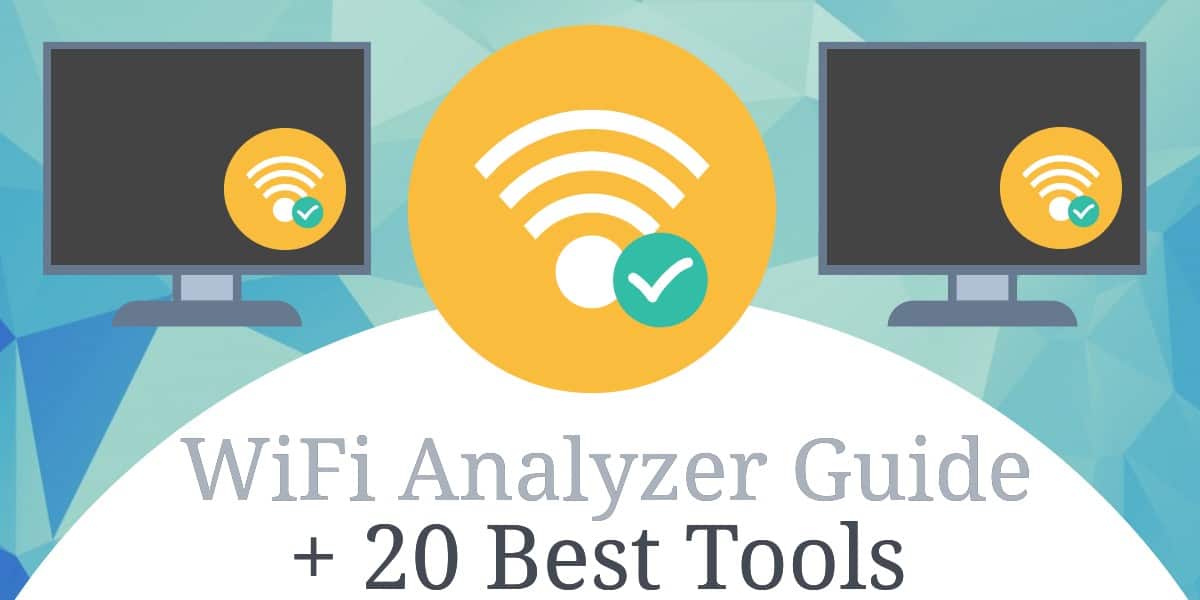
What does a WiFi analyzer do?
When it comes to WiFi, signal fluctuation is incredibly common. The reason is that your WiFi signal strength is constantly changing due to external conditions. Some days you'll be able to browse without disconnecting, and others you'll be in a battle just to stay online. T
his is made even more difficult if you don't have the tools to diagnose the problem. This is where a WiFi analyzer app can be useful.
In a nutshell, a WiFi analyzer app breaks down information from access points on your network and places it into a single screen.
A WiFi analyzer tool generates a visual display of the network data of your surrounding channels. The app turns your computer or mobile device into an analytics program that allows you to identify what you need to do to optimize your network.
For example, with a WiFi analyzer app like Microsoft WiFi Analyzer, you can look at other channels on your network and identify if they are faster than your current channel. Some providers will even allow you to draw up heat maps of signal distribution in your house or office to help you find the best location for your router.
Here is our list of the 8 best WiFi analyzers and WiFi Signal Strength Apps for Windows:
- SolarWinds WiFi Analysis with NPM EDITOR'S CHOICE – Part of the Network Performance Monitor that runs on Windows Server, this tool shows a live list of WiFi endpoint statuses and generates an amazing wireless signal heat map. Evaluate on a 30-day free trial.
- NetSpot – Built for Windows and Mac OS, this wireless monitoring system includes autodiscovery and live performance maps.
- Acrylic Wi-Fi – A WiFi analyzer for Windows that is free for home use, but business customers have to pay.
- InSSIDer – A competitively priced easy-to-use wireless traffic analyzer.
- WiFi Analyzer – A Microsoft product to analyze wireless networks that is available in both free and paid versions.
- Vistumber – A nifty free WiFi analyzer that can overlay signal footprints on a Google map.
- Wireshark – A very well-known wireless packet sniffer that aids hackers and system administrators alike.
- Paessler PRTG – The PRTG system covers wireless networks and includes alerts and capacity reports for WiFi.
Here is our list of the 5 best WiFi analyzers and WiFi Signal Strength Apps for macOS:
- Netspot – A WiFi analyzer for Mac OS that includes a heat map facility and an interference assessor.
- WiFi Explorer – A mid-level WiFi analyzer for Macs that includes signal strength indicators and noise measurements.
- WiFi Scanner – A WiFi scanner for Mac OS that is suitable for both business and home users.
- iSumbler for Mac – A WiFi analyzer for Mac OS that also tracks Bluetooth and Bonjour signals.
- KisMAC2 – A WiFi analyzer for Mac OS that includes metrics for Apple Airport Extreme.
Here is our list of the 3 best WiFi analyzers and WiFi Signal Strength Apps for Linux:
- Kismet – A free WiFi analyzer for Linux, Unix, and Mac OS that can be extended by plugins.
- wavemon – A free WiFi analyzer for Linux that is available from GitHub.
- Sparrow-WiFi Analyzer – A WiFi analyzer for Linux that tracks Bluetooth as well and can also employ GPS.
Here is our list of the 3 best WiFi analyzer and WiFi Signal Strength Apps for Android:
- WiFi Analyzer – A widely-used WiFi analyzing app for Android.
- OpenSignal – A WiFi and phone signal analyzer for Android that includes geographical maps with signals imposed.
- WiFi Monitor – A WiFi analyzer for Android produced by Microsoft.
Here is our list of the 2 best WiFi analyzer and WiFi Signal Strength Apps apps for iOS:
- Network Analyzer – A WiFi monitor for iOS in both free and paid versions.
- Master Network Analyzer Pro – A WiFi device detector for iOS that includes performance management analytics.
Why use a WiFi Analyzer?
The main reason why you need a WiFi analyzer is to maintain your connection quality. WiFi signals are in a constant state of fluctuation. Your WiFi connection can be performing well until something in the network changes and starts to impede its performance.
Troubleshooting WiFi issues
Troubleshooting a problem requires data collection and analysis. Without the source information on the normal operations of your network and the current behavior of the troubled system, your solution will be mere guesswork.
When your WiFi starts to slow down or disconnect, a WiFi analyzer will help you to identify the problem. By diagnosing the problem and addressing it, you ensure your connection stays up and running with minimal interference. A WiFi analyzer enables you to run diagnostics on what is happening with your connection and provides you with the information needed to optimize your network.
For example, if your signal distribution around the house is poor, you'll be able to use an analyzer to find this information out. That being said,WiFi analyzers can be used for much more than troubleshooting your signal distribution. You can use a WiFi analyzer to locate and use a less congested channel.
Sharing the same WiFi Channel with Neighboring WiFi networks
Sharing the same channel with nearby devices results in low connection speeds, interference, and disconnection. It's not uncommon for channels to be shared amongst your neighbors (particularly if you live in an apartment). This is one of the most common reasons for poor connectivity and can be rectified via the use of a quality WiFi analyzer.
Using a WiFi analyzer can help improve your user experience, speed up browsing, and eliminate the hassle of trying to guess what factors are impeding your connection quality while troubleshooting. After all, it's almost impossible to optimize your network if you lack the tools to be able to see what's going on.
What is a WiFi Heatmap?
Many advanced WiFi analyzers will have an inbuilt heatmap function. As mentioned above a WiFi heatmap will produce a visual display of the signal strength in your house. You'll be able to see where your signal is strongest and choose the best location for your router.
One of the best heatmap tools on the market is the SolarWinds Wi-Fi Heat Map.
Solar Winds allows the user to create custom wireless router heat maps and displays 'dead zones' where connectivity is poor. The tool works by reading the signal strength of nearby access points and indicating the quality of your connection based on signal location.
What makes this tool so effective is that the WiFi heat map can produce a physical image of an entire network site. This allows you to easily identify where your site is causing problems for your connection, and what needs to be done to address it. In short, a heat map makes it easier to improve your coverage and signal strength.
What should you look for in WiFi analyzer apps and tools?
We reviewed the market for WiFi analyzer apps and tools and analyzed the options based on the following criteria:
- A graphical representation that shows all of the channels within range
- An indicator of signal strength
- Analysis functions that indicate signal overlap
- Alerts to indicate the loss of signal or performance problems
- Identifiers for each access point transmitting signals
- A free tool or a free assessment period
- A good price that is worth paying or a free tool that is worth installing
The best WiFi analyzers for Windows
1. SolarWinds Wi-Fi Analyzer (FREE TRIAL)
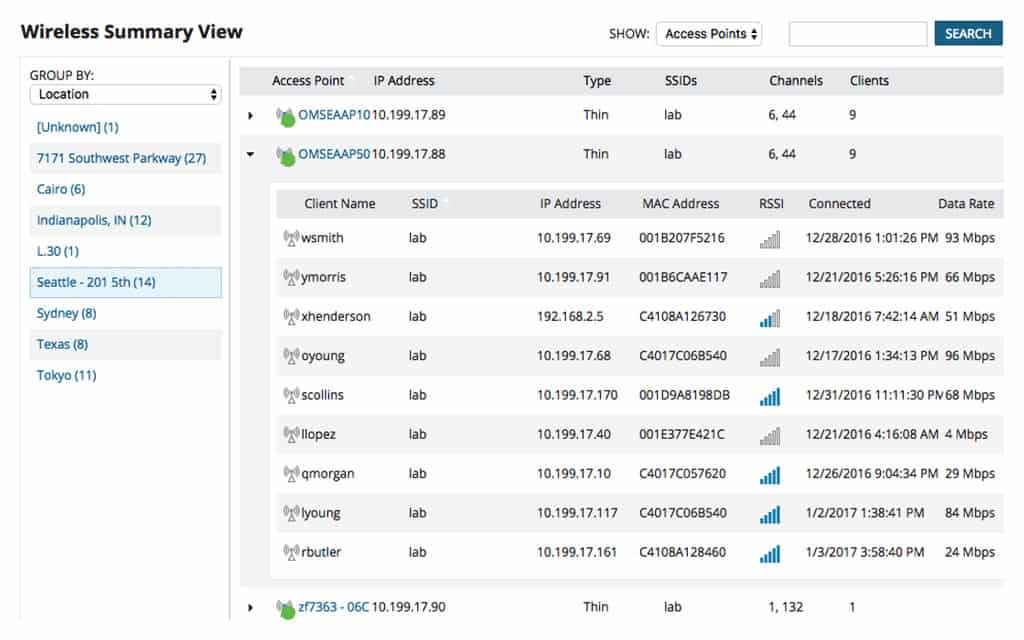
TheSolarWinds Wi-Fi Analyzermodule that comes with the Network Performance Monitor (NPM)will keep your wireless networks ticking over faultlessly. This tool begins its service life with an autodiscovery phase. The AP detection system then continues running to give you live statuses on your wireless networks.
Key Features:
- Autodiscovery includes wireless APs
- Covers all networks
- WiFi heatmaps
The inventory built up by the discovery phase automatically translates into a map of your wireless devices. You can even generate a wireless heat map by uploading a floorplan of your premises. This will show the signal footprint of all of your wireless APS and helps you see instantly where overlaps and gaps cause service problems.
The NPM tracks the statuses of all network equipment, not just wireless APs, so you will be able to see how your WiFi system fits into your wider network, including remote sites and Cloud services across the internet.
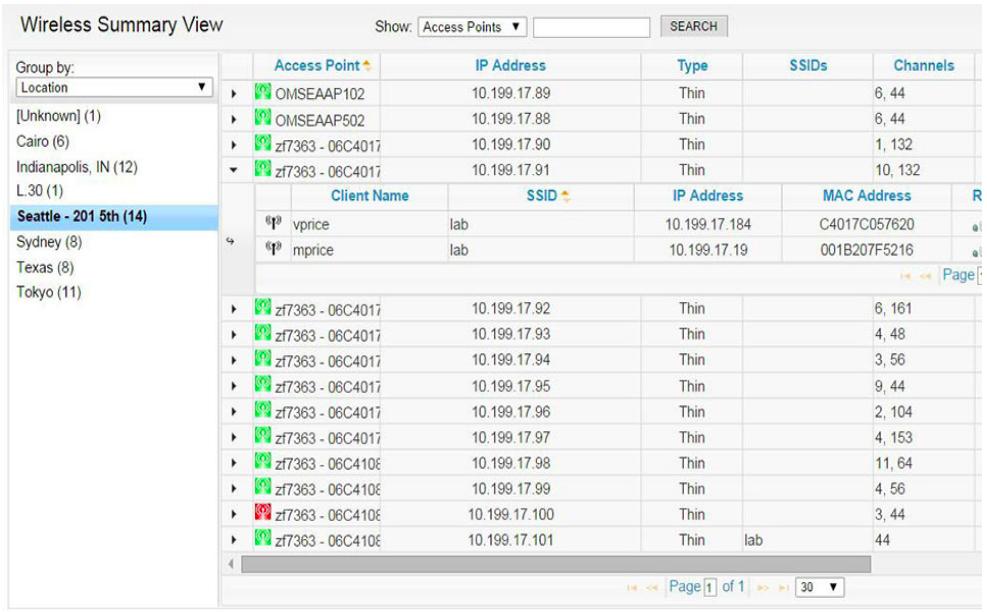
The support given by the Wi-Fi Analyzer highlights WiFi bandwidth issues and performance impairment so that you can quickly resolve network problems and improve service. The screens of the monitor contain live status reports and also include an investigative tool, called PerfStack, which uses drag and drop access to let you lay performance monitoring charts on top of each other. This gives you a clear picture of what equipment is the root cause of any performance problems, which you will see ripple through the stack of charts.
An alternative performance management monitor view in the tool is the NetPath screen. This shows you the transition points between all of the links in your network, letting you see the route that signals cross from and to your wireless networks. This is another opportunity to get a visual clue on where performance problems lie.
Pros:
- Takes a holistic approach to wireless monitoring using a number of tools to monitor and test WiFi networks
- Supports auto-discovery that collects new devices and immediately starts tracking their connectivity and performance
- Includes root cause analysis tools to help improve the troubleshooting process
- Great for wireless heat mapping as well as onsite surveys for gather data post installation
- Build to support enterprise networks and large companies
Cons:
- A feature-rich tool that requires some technical expertise to fully use all the available features
You can get the SolarWinds Wi-Fi Analyzer module as part of the NPM. It installs on Windows Server and you can access the system software on a 30-day free trial.
EDITOR'S CHOICE
SolarWinds Wi-Fi Analysis with NPM: this tool takes our top spot thanks to its wide range of features that beginner and advanced users alike will appreciate.
Get 30-day Free Trial: solarwinds.com/topics/wifi-analyzer/
OS: Windows Server 2016 or later, SQL Server 2014 or later
2. NetSpot
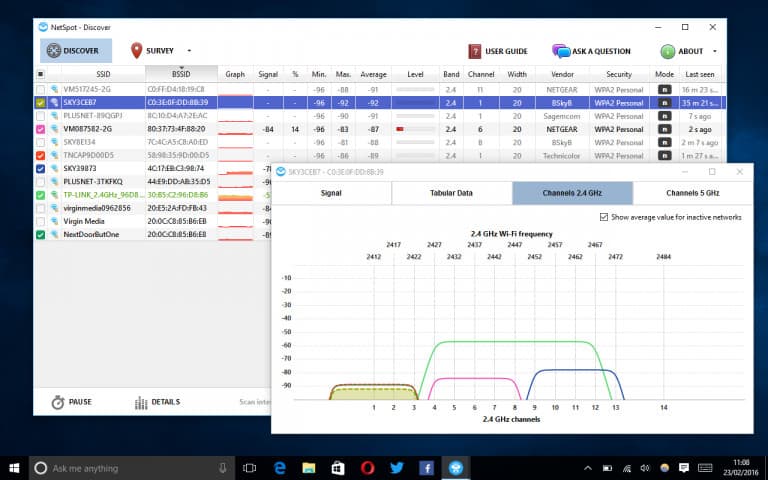
As mentioned above, NetSpot is one of the best programs on Windows and Mac because of its detailed heatmap. The user can upload a map of their location and run a survey with little complication. Once the survey has completed, the areas where your connection is strongest will be marked in red.
In NetSpot's discover mode, you'll be able to compile data from the surrounding WiFi networks and convert it into a table. On the table, you'll be able to access information on the SSID, MAC Address, Signal Information, and Vendor.
Pros:
- Can operate on both Windows and Mac platforms
- Is very user friendly, and allows user to easily upload their own maps for site surveys
- Balances technical features with ease of use that finds a nice middle-ground for most users
Cons:
- Would like to see more export and reporting functionality
- The evaluation version is limited and doesn't offer a good feel for the product before purchase
Likewise, you can convert this data into a CSV file to create a paper record. The program's combination of simplicity and technical detail makes it suitable for both home users and network administrators.
3. Acrylic Wi-Fi

Acrylic Wi-Fi is a free wifi analyzer designed for Windows. The user can scan for local wireless routers and compile a table of the relevant details. All the core metrics are included in the table, such as MAC address, SSID, RSSI, channel, and vendor.
In addition, the monitor mode allows the user to monitor network packets, which can be used to locate hidden networks. Unfortunately, Acrylic is only free for personal use, and business users will have to obtain the professional version.
Pros:
- Free tool with a paid option for more in-depth features
- Supports a monitoring mode for packet capture
Cons:
- Interface can feel overwhelming and cluttered when scanning larger networks
- Difficult to get started, could benefit from a simple tutorial or additional support
The professional version can be obtained for a one-off fee of $47.99 (£34.52), which grants the user access to more detailed network information and report generation.
4. InSSIDer
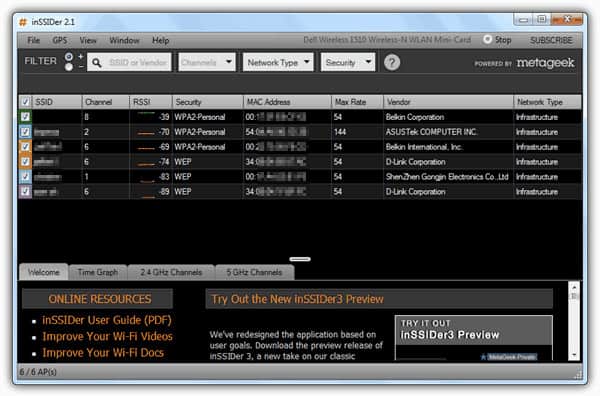
At $19.99 (£14.38), inSSIDer is one of the most competitively priced WiFi analyzers on the market. The app breaks down all the relevant data about your nearby wireless networks whilst detailing a variety of information on your access points. Users are able to view information on everything from encryption type to signal strength and channel.
What makes inSSIDer stand out is its ease of use. To find more information about a network, you simply right-click on it and you will be shown a menu of data to single out. You can click on SSID, signal, channel or network type to see more information on that category.
Pros:
- Simple yet efficient interface
- Easy to use, even for non-technical users
Cons:
- Lack enterprise functionality, reporting, robust alerts, etc
- Limited features make this not the best option for sysadmin
- Could use better spectrum analysis coverage
The simplicity of the user interface makes it ideal for less experienced users but network professionals will find the functions to be limited. For example, most versions of insider don't offer GHz channel utilization or 5 GHz spectrum analysis.
5. WiFi Analyzer
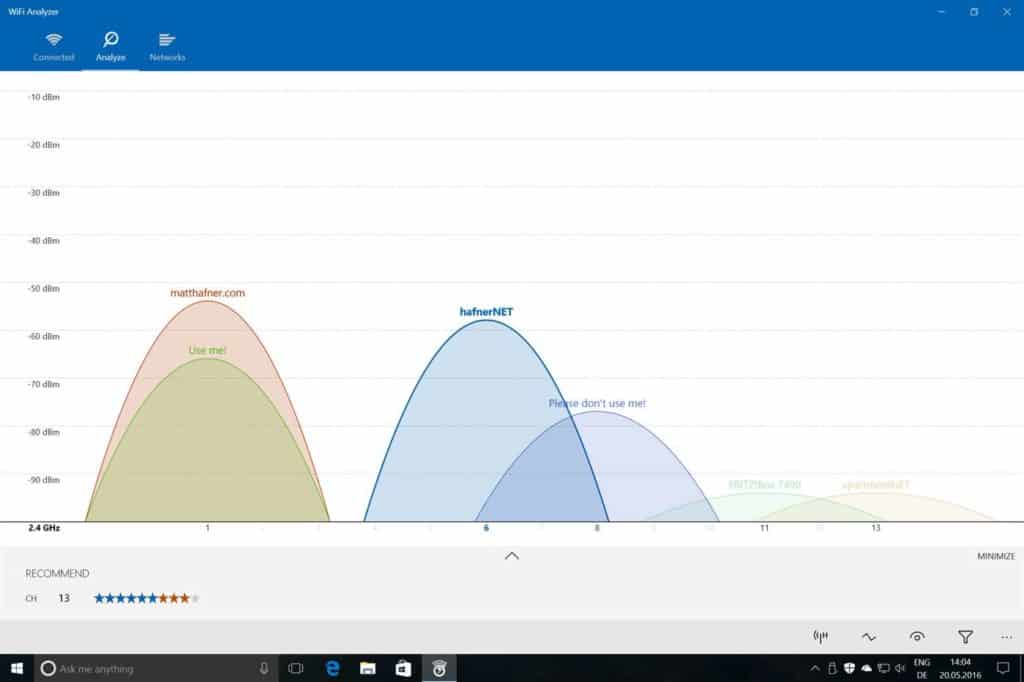
WiFi Analyzer is Microsoft's answer to poor connectivity. Users looking for an easy-to-use WiFi analyzer should look no further. The app has been designed specifically for home users and transforms the user's network into a visual display where they can clearly see their signal strength.
Like many other apps on this list, WiFi Analyzer is available in both a free and a pro version for $2.99 (£2.15). The free version provides you with all you need to produce graphical displays and identify problems within your network.
The pro version builds on this by providing an auditory beeper for signal strength and the ability to change signal strength borders. As a bonus, the user can also connect straight to a new network via the app.
Pros:
- Supports a free and pro version
- Simple interface makes the tool easy to use and beginner-friendly
- Pro version offers an audible signal when performance issues occur
Cons:
- Better fit for small networks and home users, not detailed enough for larger networks
- Sacrifices technical metrics to become more user friendly
The simplicity of the user interface and the visual display make this an ideal choice for those new to WiFi analyzer tools. WiFi Analyzer makes it easy to look up available channels on your network and transition to the one that's optimum.
6. Vistumbler
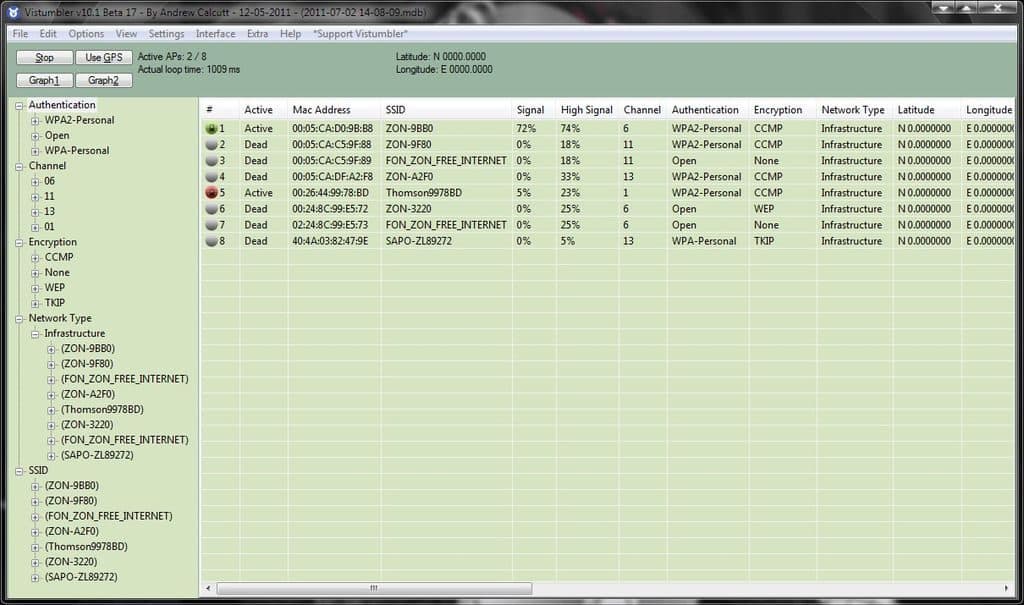
If you're looking to run WiFi analytics on a budget, Vistumbler should be your first port of call. This free tool allows the user to locate nearby access points and collect data on their signal strength. When using the platform you can create a unique graph of every network in your vicinity.
Vistumber's graphs make it easy to identify which networks are performing well, and what you can do to improve your own network performance monitoring. If you're looking for more of a location-based approach, then you'll need to add a GPS to your laptop.
If you do this you'll be able to generate an infrastructure wireless network map over a Google earth image. This means if Vistumbler finds a network it pinpoints it on the map with its accompanying information (name, encryption type, signal strength). The only problem with Vistumber is that it's not easy to use.
Pros:
- Completely free tool
- Supports built-in graphing that is automatically created based on devices in the area
Cons:
- Interface is limited and not ideal for enterprise-size networks
- Not as user friendly for non-technical customers
- Steeper learning curve than most other WiFi analyzers
Vistumbler was originally designed to enable users to search for WiFi networks in moving vehicles, so it's not tailored toward home or office users. However, once you get past the initial learning curve, it offers more than enough to optimize your network.
7. Wireshark
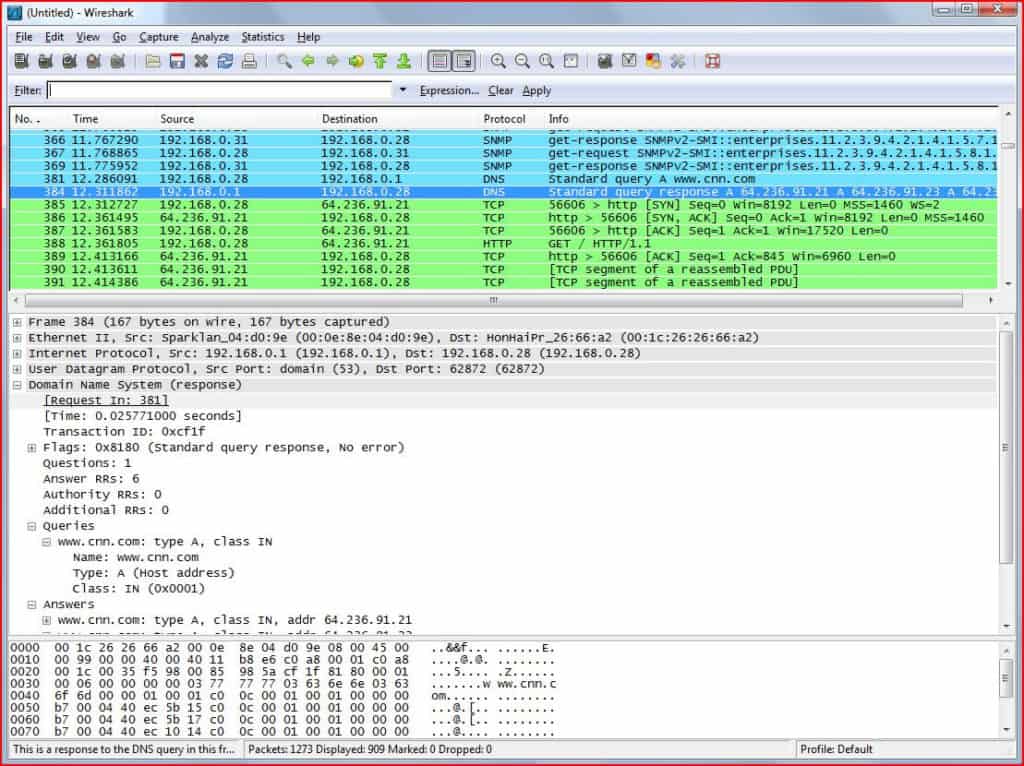
Finally, we have Wireshark. While technically a packet analyzer and robust open-source network analysis tool, Wireshark can also be used as aWiFi analyzer tool for Windows, Mac, and Linux. This free program is tailored towards both professional and home users. Wireshark is a powerful network analyzer and has the strength to generate data on an entire office network.
The system offers live data capture so that you can see real-time network connections and look for connectivity issues. Likewise, you can also run decryption and VOIP analysis to improve the visibility of surrounding networks
Pros:
- One of the most in-depth tools for wireless technical analysis
- Lightweight application that can run on nearly all machines
- Supports verbose live data capture
- Can integrate into more robust data collection systems
- Is completely free
Cons:
- Technically a packet analyzer and not a WiFi analyzer, makes it more difficult to configure specifically for wireless devices
- Has the highest learning curve when compared to its competitors
- Requires deep technical knowledge, not user friendly
The only problem with Wireshark is there's not much in the way of external support. There's an active community but little to no supporting documentation to help users with any problems that arise.
That being said, the diverse functionality of the platform offers more than enough to provide home and office users with an industry WiFi standard analyzer suite.
8. Paessler PRTG

Paessler PRTG will discover all of the network devices on your network including WiFi routers. The discovery phase of the network monitor's operations creates a network map. This shows which other devices on the network are connected to your routers.
Key Features:
- Measures wireless traffic volumes
- Spots device problems
PRTG uses three methods to monitor WiFi routers. SNMP, which is the Simple Network Management Protocol, informs the central collector of a monitored router's statuses. This information includes the throughput capacity and health of the router. The NetFlow messaging protocol is the second monitoring medium used by PRTG. This standard broadcasts network traffic metrics, which are picked up by the PRTG collector. The third monitoring system for WiFi routers is the PRTG packet sniffer. This examines the headers of packets crossing your network. The tool only captures the headers of those packets, so your data privacy is preserved. The packet sniffer reports on traffic volumes by application, port number, and protocol.
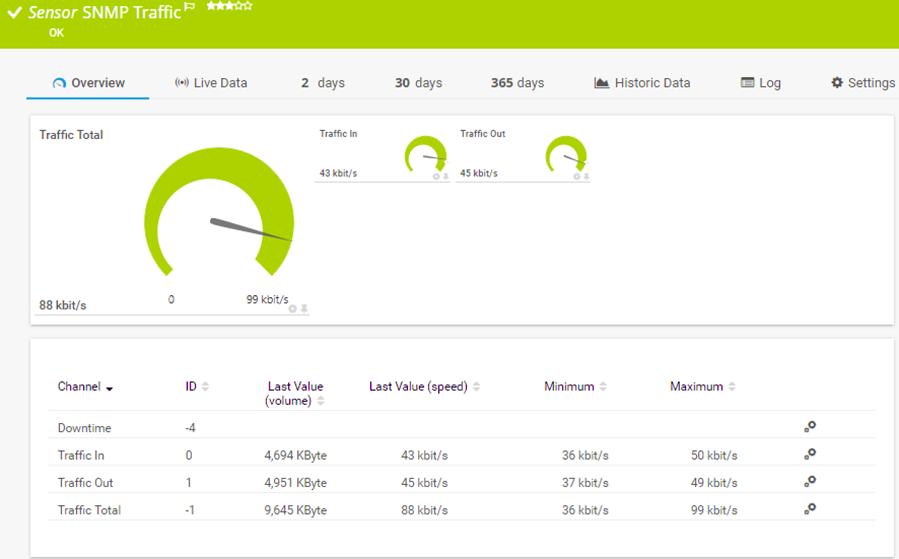
The interface of PRTG interprets all of the data collected on your WiFi networks, creating graphs of real-time data and also charts of historical data.
Any problems arising in the router that could cause an interruption of service get reported to the monitor as soon as they arise. These alerts highlight overloading or equipment failure. You can set warning points so that the system will notify you if traffic approaches critical conditions. You can even create custom alerts that combine several different conditions.
Pros:
- Features autodiscover which builds lists and wireless maps based on devices in the area
- Collects data through SNMP and packet sniffing
- Features a host of reporting templates and dashboard configurations making the tool very customizable
- Uses simple builtin visualizations to assist NOC teams in monitoring
- Supports 100 free sensors for an ample trial period
- Pricing based on the number of sensors makes the tool both flexible and scalable for any size network
Cons:
- PRTG is feature dense, requiring time with the product to fully utilize its features and options
Paessler PRTG installs on Windows or you can also opt to get the system as a cloud service. Paessler charges for PRTG according to the number of sensors that you activate. PRTG is free if you only want to monitor up to 100 sensors. PRTG comes with a 30-day free trial.
Paessler PRTG Download FREE 30-Day Trial
The best WiFi analyzers for MacOS
1. NetSpot
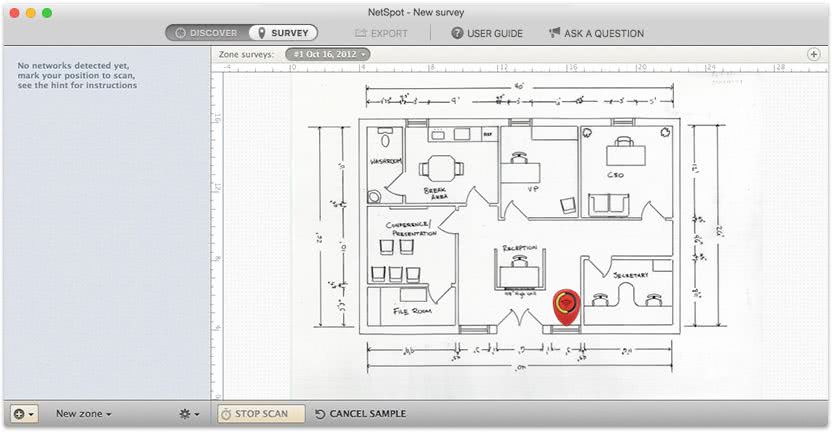
When it comes to WiFi analyzer apps for Mac, Netspot is one of the best offerings on the market. Netspot offers a detailed heat map that allows the user to identify signal strength in their surrounding location. The app collects data on everything from channel width, to MAC address, signal quality, and network encryption to provide more transparency over your local network.
Key Features:
- Detects interference
- WiFi footprint on an office layout
- Signal channel analysis
- Free version
Unlike many other analyzers, NetSpot allows you to assess WLAN interference as well. What really sets this app apart from the crowd is the depth of its reports, ease of use, and network information. The program color codes areas of signal strength, with weak signals being highlighted by purple or blue.
Pros:
- Great option is only using a Mac
- Calculates WLAN interference and can help guide changes based on neighboring signals
- Uses simple color-coding to guide users for best device placement and channel selection
- Features a free mobile app
Cons:
- Not designed for enterprise networks
- Mapping features could be easier to use
The scalability of the heat map renders NetSpot ideal for both home and office users. The home version is available for $49 (£35.26) and the professional version for $149 (£107.21). However, the app provides another version where users can scan for local networks and view signal strength data for free.
2. WiFi Explorer
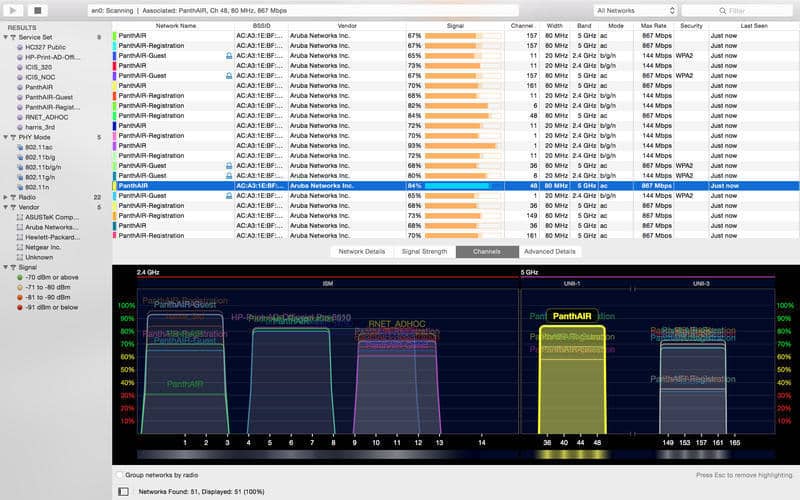
As one of the best mid-level tools on this list, WiFi Explorer is a solid alternative for beginners and experienced users alike. When a user launches WiFi Explorer they can start to locate local wireless networks immediately. Once this occurs, the user can flick through the networks identified via the use of the on-screen tabs.
Key Features:
- Displays signal strength
- Covers 2.4 GHz and 5 GHz channels
- Identifies signal origin
Users can look through everything: network details, signal strength, 2.4 GHz and 5 GHz channels. The signal strength tab is WiFi Explorer's version of the heatmaps seen in other apps like SolarWinds.
You can simply set the app to measure signal strength data and it will produce a graph as you walk around your building. The only drawback is that you won't be able to detect hidden networks. This is because Apple doesn't provide the necessary data to detect hidden wireless networks.
Pros:
- Provides a solid balance between functionality and in-depth WiFi metrics
- Full channel analysis for both 2.5 and 5 GHz channels
- Interface is easy to learn and balances visuals with device metrics nicely
- Best suited for medium to large size wireless networks
Cons:
- Requires some networking knowledge to use, not the best non-technical option available
It's worth mentioning that the app also provides a range of information to assist more experienced users looking for advanced functionality. You can identify information such as the SSID, BSSID, signal-to-noise ratio, and signal quality after you've identified another network. Whether you're looking to break down your network performance or locate a more efficient channel, WiFi Explorer has you covered.
3. WiFi Scanner
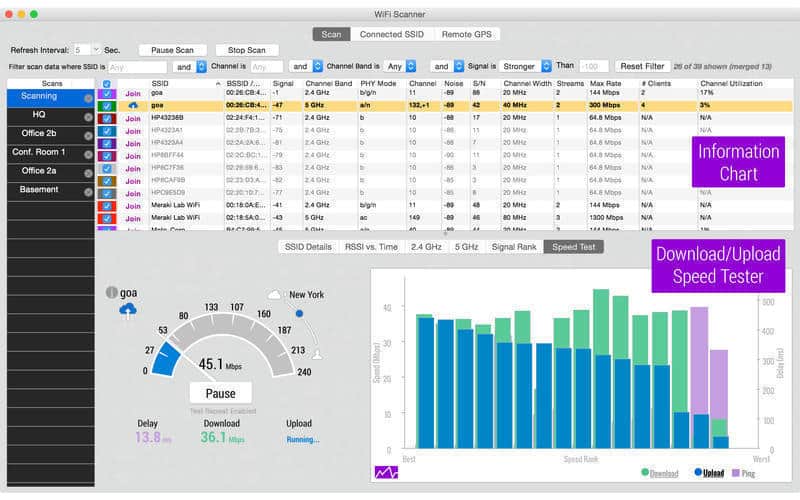
AccessAgility's WiFi Scanner is one of the best-kept secrets when it comes to WiFi analyzers. This competitively priced tool retails at $14.99 (£10.79) allows users to analyze their networks download and upload speeds with simplicity. This makes it ideal for home users who don't have a large budget.
The app breaks down access points in the surrounding area and provides information such as BSSID and MAC addresses. Unlike many other tools on this list, WiFi Scanner also enables the user to detect unauthorized devices on the network through the use of an IP scanner. This makes it a great tool for overall network transparency.
Pros:
- Competitively priced
- Can help administrators detect rogue access points and unauthorized devices on the network
- Better suited for small LANs and home users
Cons:
- Not the best fit for enterprises
- Lacks in-depth reporting and auditing features
4. iStumbler for Mac

Rather than opting for a visual display, iStumbler scans for WiFi networks and puts them into a list. This list is updated in real-time so you can click on any networks you see and view more detailed information like dBm values.
You'll be able to see how much signal there is available, as well as any noise on a given channel. It's worth mentioning that you can also break down Bluetooth, Bonjour, and locations connections beyond your WiFi signal.
Pros:
- Automatically pulls wireless network information into a list in real-time
- More beginner-friendly than some other Mac-specific products
Cons:
- Free version is filled with ads and nagware
- Doesn't provide any detailed visualizations
- Sacrifices some technical details to remain more user friendly
Unfortunately, the free version bombards the user with endless pop-ups encouraging them to upgrade. However, this can be avoided if you choose to upgrade to the $20 (£14.39) version. The depth of the signal data and the ease of use of the platform make this a good choice for users who are new to the world of WiFi analyzers.
5. KisMAC2
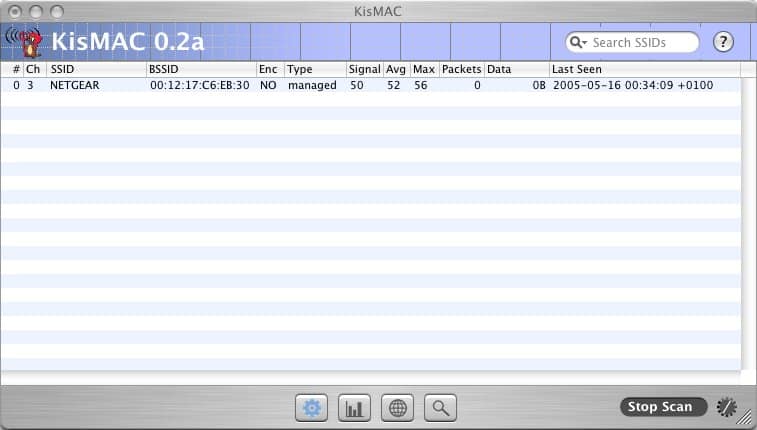
KisMAC 2 is a formidable and technical open-source WiFi analyzer that supports a wide array of WiFi analytics functions. Like other programs, all you need to do to start scanning your network is press start. You'll then be able to break down your network signal strength, though KisMAC's capabilities go far beyond that.
You can also analyze USB WiFi adapters, Kismets servers, and drones. In terms of more advanced features, KisMAC2 helps the user break down SSIDs whether they're open, hidden, or closed. Likewise, the platform supports Apple Airport Extreme, which helps to extend your network transparency even further.
Pros:
- Transparent open-source project
- Can sort SSIDs based on their status, hidden, open, closed
- Integrates with Apple products like Apple Airport Extreme
Cons:
- Aimed more towards professionals, can be challenging for beginners
- Visualization feature could benefit from more options
- A more functional reporting feature would be a welcomed feature
The only limitation is that KisMAC is aimed at professional users and it can be very difficult for newer users to navigate.
The best WiFi analyzers for Linux
1. Kismet
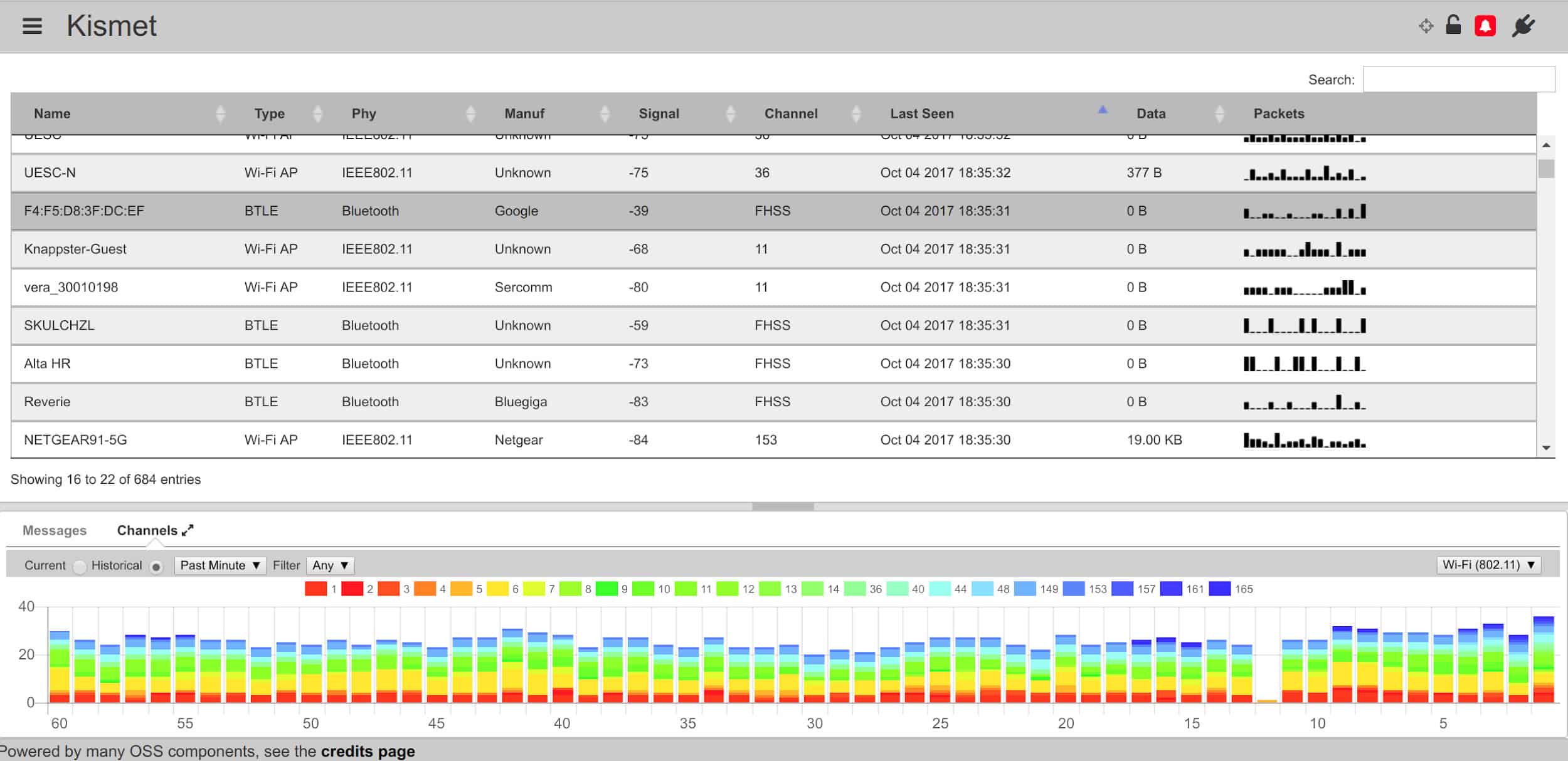
Kismet is a WiFi analyzer or network analyzer designed to work with IEEEE802.11 WiFi cards. Kismet is often used by Linux users but can also be used on FreeBSD, NetBSD, OpenBSD, and Mac OS as well. This tool is widely used because it offers support for a range of protocols including Bluetooth and RTL433.
Key Features:
- Detects Bluetooth as well as WiFi
- Expandable with plugins
- Customizable
- Free to use
The Kismet 2018 version is offering a number of features that enhance the basic functionality of the platform. Now when working with a large team you can conduct real-time live streaming of captures to share information with other colleagues on network activity. If you wish to customize your experience then you can make use of external tool APIs to add additional features.
Kismet has a number of plugins available to expand on the basic product including Kestrel, IoD – Screwdriver, and Elkentaro's Simplified Mobile Dashboard and ElKentaro's Simplified Mobile Dashboard.
Pros:
- Available for Linux, Mac, and OpenBSD
- Can scan for Bluetooth signals along with other wireless protocols outside of Wifi
- Allows for real-time packet capture that can be forwarded to multiple team members
- Uses plugins for additional features keeps the base installation lightweight
- Free to use
Cons:
- Designed for smaller networks
- Lacks enterprise-level reporting capabilities
- Reliant upon the open-source community for support and updates
Kismet can be downloaded for free.
2. wavemon
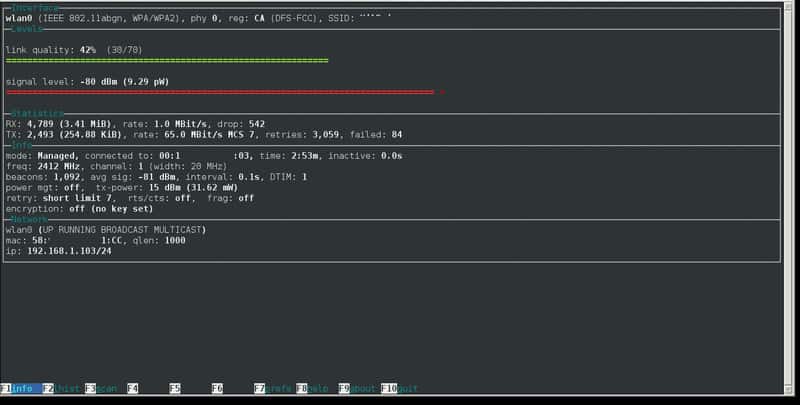
wavemon is a free open source WiFi analyzing tool that allows users to monitor network devices on Linux. To use wavemon, you'll need to enable wireless extensions. When using a kernel setup with CONFIG_CFG80211 you need to make sure that the CONFIG_CFG80211_WEXT package is activated. You will also want to make sure that you have the pkg-config package.
Key Features:
- Open source and customizable
- Easy to install
- Free to use
Once you've done this the user experience is quite straightforward. wavemon uses autoconf so that you can make your way through the setup process promptly.
Pros:
- Lightweight tool, great for resource-strapped system
- Autoconf can help the user get started upon installation
- Project is open-source
Cons:
- Command-line interface, no GUI
- Installation can be more complicated than similar tools
- Lacks detailed visualization capabilities
- Lacks advanced reporting features
- Bug fixes and support is tied to the open-source community
The program is kept updated on Github so that you can add updates regularly. wavemon is available as source code from GitHub via this link here.
3. Sparrow-WiFi Analyzer
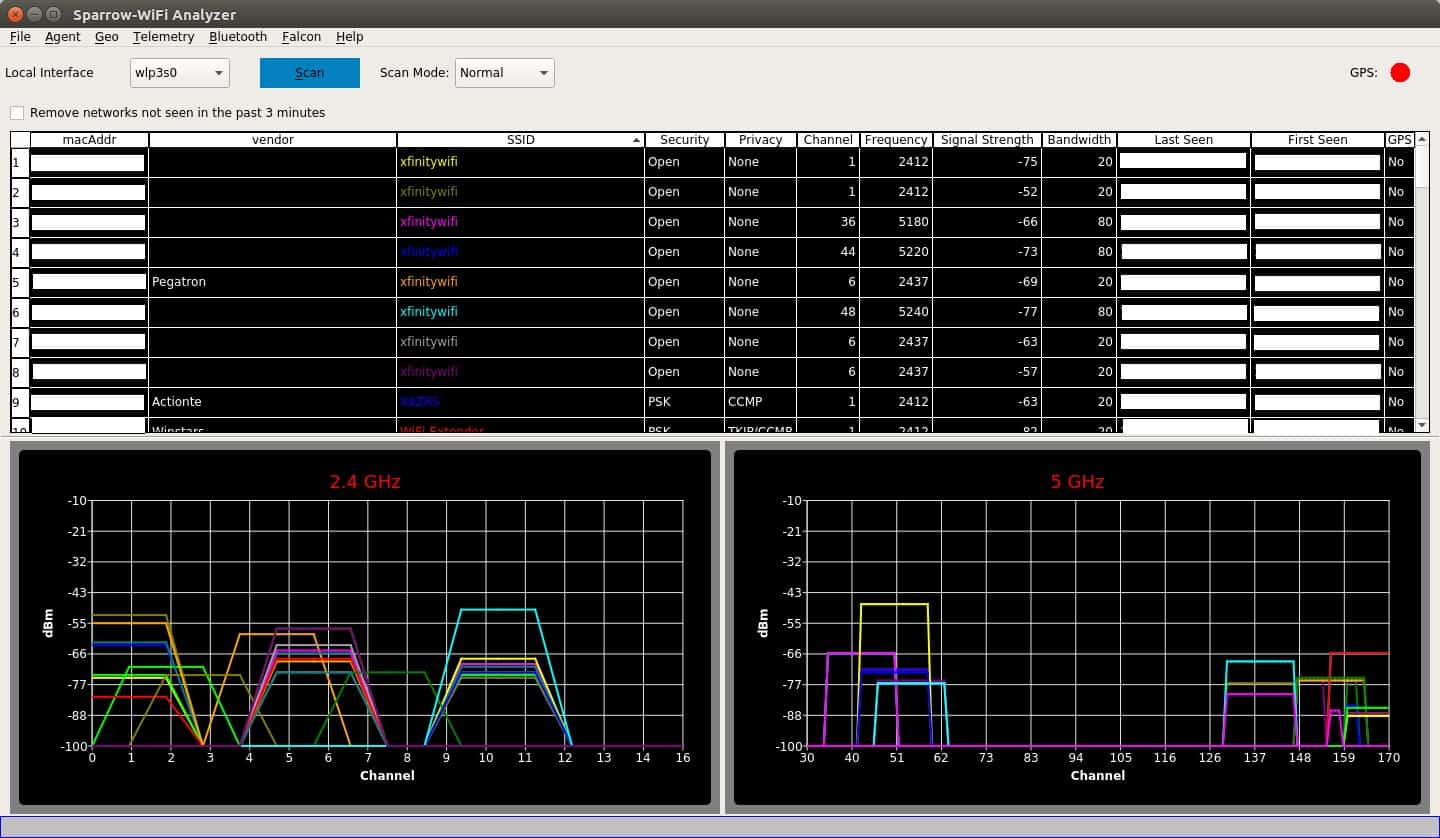
Sparrow-WiFi Analyzer is a 2.4 GHz and 5 GHz WiFi and Bluetooth analyzer for Linux. The sparrow-wifi platform has been positioned as a more GUI-friendly replacement for other tools like inSSIDer and linssid. When using this WiFi analyzer you can conduct WiFi SSID identification and track WiFi sources.
The installation process for sparrow-wifi is very simple. On Debian, you will need qtchart and on Ubuntu and Linux you will need to enter a couple of commands to get running:
sudo apt-get install python3-pip gpsd gpsd-clients python3-tk python3-setuptools sudo pip3 install QScintilla PyQtChart gps3 dronekit manuf python-dateutil numpy matplotlib There is also the ability to use GPS to track SSID's and Bluetooth devices. sparrow-wifi enables you to create Google maps that log these for you.
Pros:
- Can scan and detect Bluetooth networks alongside WiFi
- Offers a graphical interface, unlike some other Linux-only tools
- Supports GPS tracking for more accurate mapping of devices and networks
Cons:
- Interface is barebones and feels lacking at times
- Is designed with more advanced users in mind
If you need to further analyze your WiFi results then you can also import and export data to CSV and JSON. If you'd like to download sparrow-wifi then you can do so from this link here.
The best WiFi analyzer apps for Android
1. Wifi Analyzer
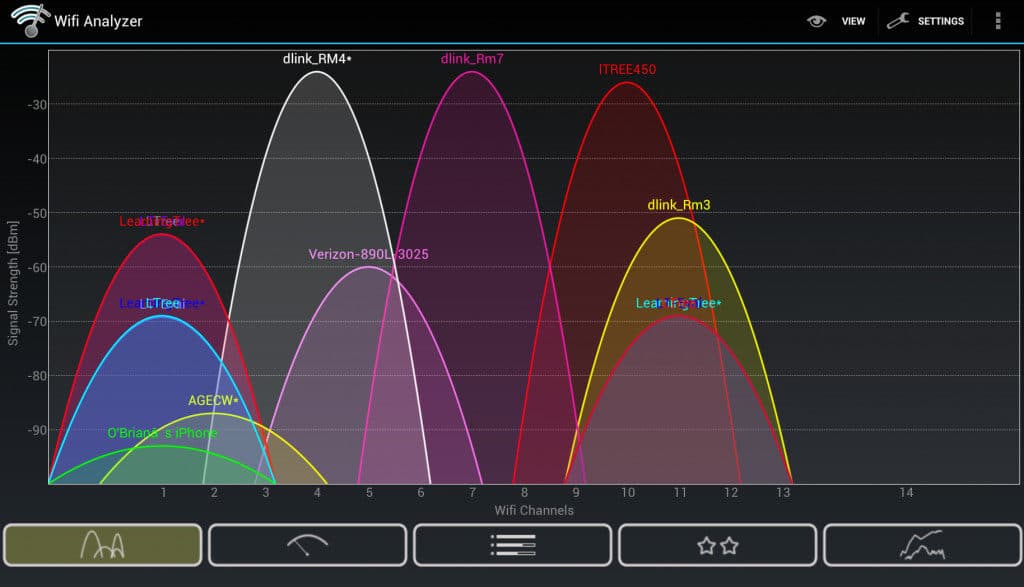
When it comes to wifi analyzers for Android devices, Wifi Analyzer is a name that keeps cropping up. With over 10,000,000 installs, this app is one of the most established wifi analyzers on the platform. Wifi Analyzer is adept at identifying nearby networks. The app will scan and create a visual representation of your WiFi signal.
Key Features:
- Great visual representation
- Shows signal strength
- Detects all neady Apps
- Free to use
This visual image is great for providing an overview of your local channels. As soon as you load up Wifi Analyzer you're shown an image of nearby signals that allow you to identify over-saturated channels. This makes it much easier to spot a less congested channel and move accordingly.
Pros:
- One of the easiest mobile apps on the market
- Uses simple yet informative graphics to visualize neighboring networks, devices, and channel utilization
- Is available for free
- Good for quick on-site troubleshooting
Cons:
- Includes ads in the app
- Lacks enterprise reporting
- Does not support long term monitoring
This effective app is available for free although you will have to tolerate some on-screen advertisements.
2. OpenSignal

OpenSignal is one of the most versatile apps on this list. You can see your WiFi signal strength and coverage on a virtual display and run speed and latency tests. What really sets OpenSignal apart is its detailed maps system. You can view a map of WiFi hotspots and phone towers to see where network connection quality is best. It's worth noting that the phone towers are shown only pertain to your telephone provider.
Key Features:
- Plots WiFi signals on a real-world map
- Monitors mobile signal as well
- Free to use
OpenSignal is the best choice for users looking to monitor both their wifi and mobile devices' signal coverage. Of course, you can still generate extensive wireless network information if you are looking to stick to the fundamentals.
Pros:
- Can run latency and speed tests directly in the app
- Can pull up a geographic map to find open networks and hotspots
- Supports cellular network detection
- Free with no ads
Cons:
- Not an enterprise solution, more for quick on-site troubleshooting
- Lacks long term monitoring capabilities
- Does not support a full-fledged desktop version
This app is also competitive in terms of price, being available for free with no onboard advertisements.
3. WiFi Monitor

Microsoft's WiFi Monitor has made a name for itself on Android for good reason. The app combines substance with a simple user interface. 4 tabs (Connection, Networks, Channels, Strength) allow the user to delve deep into their network parameters. The Networks tab breaks down all nearby WiFi networks and the Channels tab shows how your WiFi channels are distributed.
Pros:
- Sleek user interface with a minimalist design
- Breaks down metrics by tab, making it easy to study large volumes of wireless data
- Tracks data sent and received on your mobile device
Cons:
- Does not support long term monitoring from your phone
- Would like to see more alert options
You can then use the strength chart to assess your signal strength and to identify where you have a weak signal. Under the speed chart, you're provided with a detailed breakdown of all the data you've transmitted and received. If you're looking for a free app that has core functions with depth, WiFi Monitor should be your first choice.
The best WiFi analyzer apps for iOS
The iOS operating system blocks access by apps to the WiFi processes or network connection hardware. That presents a big problem for the designers of wireless packet sniffers. However, some valiant system software producers have taken a shot at producing WiFi analyzers for iPhones and iPads. Check out the following options:
1. Network Analyzer

Network Analyzer does a good job of presenting network information within the constraints of the iOS operating system. The service is produced by Technet and is available in two versions. New users can only download and install the free editions, which is called Network Analyzer Lite.
Key Features:
- Displays signal strength
- Shows transmission times to nearby devices
- Also shows cell networks
- Free and paid versions
The tool includes a Wi-Fi LAN scanner, which spots all network devices on a wireless network. The tool shows the round-trip response time to each detected device, using Ping. It can also deliver the IP address of each device and show the device's location with a flag icon. The scan can also tell you the cell network details of each device within range and other wireless network data.
Pros:
- Comes in two versions, freeware and paid
- Easy to use tests allow users to calculator latency, jitter, and response time with ease
- Can track WLANs and external IP addresses
- Supports cellular network statistics
Cons:
- Dashboard couple be simplified to be easier to navigate
- Could support layer 3 Netflow traffic
Once you have Network Analyzer Lite installed on your iPhone or iPad, you have the option to upgrade to the full version. Network Analyzer shows connection details with the route displayed on a world map. It will also give you network speeds to reach various locations around the world, not just ping details on your current wireless network.
2. Master Network Analyzer Pro

Master Network Analyzer Pro detects details of the current wireless network that the iOS device is connected to and also offers a series of tests for the network and any connections made from the device.
Key Features:
- Connection quality tests
- Signal strength detection
- Free to use
The scanner details network information, such as the gateway IP address, DNS server IP address, the device's allocated IP address on the network and the network's IP address for the outside world. It will also show all other devices connected to the same wireless network and give information about each of those.
Analysis and connection testing utilities in the tool include ping, traceroute, a speed test, a DNS lookup, and a Whois feature.
Pros:
- Has one of the better user interfaces for iOS wifi analyzer apps
- Can full DNS, gateway, and IP address information from devices
- Supports basic testing including whois lookups
- Also available for Android
Cons:
- Better suited for personal use
- Lacks in depth WiFi testing features
The Master Network Analyzer Pro tool is free to use and it is available for Android as well as for iOS. This app is probably more appropriate for personal use than for businesses. However, individuals in a business who need to travel to other sites and locations, such as sales agents of craftsmen, might find it useful.
WiFi Glossary
- dBm – dBm stands for decibel-milliwatts. dBm is the measurement used to measure the strength of a WiFi signal.
- IP Address – A unique number punctuated with full stops used to identify a computer communicating via a WiFi network.
- MAC Address (Media Access Control Address) – A unique identifier used to refer to a network adapter over a network.
- RSSI (Received Signal Strength Indicator) – A measurement used to identify the strength of a radio signal.
- Signal to Noise Ratio – The ratio of an electrical signal's strength compared to outside interference.
- SSID (Service Set Identifier) – The technical name for a WiFi network name.
- Vendor – A wireless network provider.
- WiFi Channels – A WiFi channel is where WiFi networks exchange data (Channels 6 and 11 are where most routers exchange data).
- Wireless Access Point (WAP) – A hardware device or configured node on a local area network that allows wireless devices to connect through WiFi and Bluetooth connections.
- WLAN (Wireless Local Area Network) – A network that allows devices to connect, interact and communicate with each other wirelessly.
How to get a better signal and connection using a WiFi analyzer?
Whether you're a home user or a battle-tested network administrator, a WiFi analyzer is a vital tool for managing your network. If you want to maintain the connection speed and integrity of your WiFi connection, then a WiFi analyzer app should be a high priority.
There are plenty of different options available on the market. If you want to have full WiFi coverage it's a good idea to look for a model with an inbuilt heat map, as this is the most effective way to see a real-time depiction of your local signal strength.
Ultimately you're looking for an app that's easy to use and offers the functionality needed to achieve your needs. A home user might be able to scrape by on a free program, but an entire department will need a more powerful solution.
Taking some time to research the right tool for your business will allow you to optimize your online experience much more effectively. Whether you're a home or enterprise user, doing your research is the key to finding the WiFi analyzer app that's right for you.
WiFi Analyzer App FAQs
What are the best channels for my wireless router?
In the 2.4 GHz band, channels 1, 6, and 11are the best options for a router because they do not overlap with other channels.
What channel is best for 5GHz?
In the 5GHz band, channels 36, 40, 44, and 48 are reserved for domestic use and so do not overlap with bands used for commercial, weather, or military purposes.
Should a wifi extender be on the same channel?
Yes. You should have your WiFi extenders on the same channel as your router. However, to avoid confusion at times when you want to analyze signal strength give each extender a different SSID that is also different from the one assigned to the WiFi router.
WiFi Analyzer FAQs
What is the difference between a WiFi analyzer and a WiFi Signal Strength app?
A WiFi analyzer has more functions than just displaying signal strength. A signal strength app will show you the strength of the signal for the channel to which you are connected. A WiFi analyzer shows all networks currently within range for a specific spectrum. That means, once you have selected whether to analyze the 2.4 GHz band or the 5 GHz band, the analyzer identifies all transmitting wireless access points nearby. It will show all available channels for each and the signal strength of each channel.
What is the best WiFi Analyzer app for iPhone?
Try one of the following WiFi analyzers for iPhone:
- NetSpot for iOS
- WiFi Analyzer by Master App Solution
- Network Analyzer by Technet
- Wi-Fi SweetSpots
- Scany
What is the best WiFi Analyzer for Android?
Try one of the following WiFi analyzers for Android:
- NetSpot for Android
- WiFi Monitor
- OpenSignal
- Network Signal Info
- ScanFi
What do WiFi Analyzer apps tell you?
WiFi analyzer apps scan the environment to discover the signals that are of sufficient strength to be picked up by a receiver. The analyzer then gathers the identifiers for those signals, which are called SSIDs, or Service Set Identifiers. It then displays the signals arriving from each WiFi access point, displaying its available channels and the signal strength of each.
Is there an app to test WiFi signal strength?
There are many apps to test WiFi signal strength, these are written to work with specific operating systems, so there will be a different list for each. Check out the Airport Utility App for iOS devices, or Wi-Fi Analyzer for Android. All WiFi enabled devices have their own built-in WiFi signal strength detectors for the current connection. These show a ripple of bars in a quarter circle or a cone, In either design, the outer areas of the icon light up when the WiFi signal gets stronger.
How can I make my WiFi signal stronger?
To improve the strength of WiFi signal that your device receives:
- Move closer to your WiFi access point
- Get a WiFi router with a stronger transmitter
- Install a WiFi booster
- Turn off smart devices that constantly access the WiFi system to reduce congestion
- Switch to a different WiFi channel
- Switch to a faster WiFi standard – e.g. a 5 GHz system
See also: The Best WiFi Stumblers
Is There An Android App For Tracking Down Wifi Signal Sources
Source: https://www.comparitech.com/net-admin/wifi-analyzers/
Posted by: spatesbrin1959.blogspot.com

0 Response to "Is There An Android App For Tracking Down Wifi Signal Sources"
Post a Comment